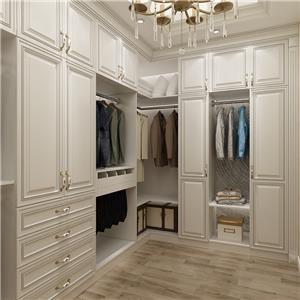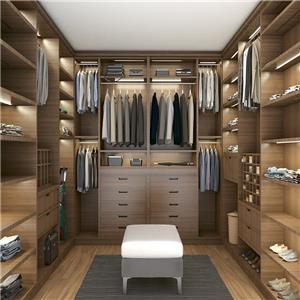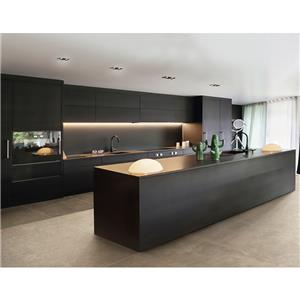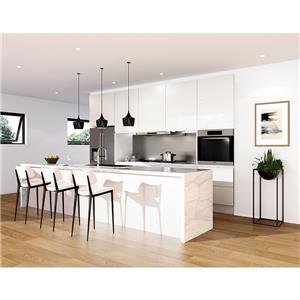The pros and cons of solid wood kitchen cabinets
Solid wood kitchen cabinets are natural, environmentally friendly, durable, customizable and rich in cultural heritage, making them the first choice for many families when decorating their kitchens. Although the price is relatively high, the long-term benefits and improved quality of life they bring make this investment particularly worthwhile. However, like any other material, it has its own set of advantages and disadvantages. In this article, we will explore the pros and cons of solid wood cabinets.
1.Solid wood in kitchen design exudes timeless charm and warmth, with its unique grain patterns and natural variations adding depth and character. Durable and long-lasting, it can be crafted into custom designs, from elegant cabinets to sturdy countertops, blending rustic authenticity with sophisticated elegance. Solid wood invites a sense of luxury and connection to nature, making kitchens feel inviting and homely.
2.Solid wood, prized for its durability and aesthetic appeal, is a premium choice for cabinetry. It offers natural beauty with unique grains and hues that mature over time. Resistant to wear, solid wood cabinets can be sanded and refinished, extending their lifespan. While it may expand and contract with humidity changes, proper sealing and maintenance ensure lasting performance and a classic, inviting look in kitchen design.
3.Before investing in any major upgrade, like solid wood cabinets, it's crucial to grasp the complete picture. This includes evaluating the upfront cost versus long-term value, considering maintenance requirements, and ensuring the chosen material aligns with your lifestyle and design aspirations. Understanding the implications on resale value, durability, and personal enjoyment helps make informed decisions for a satisfying and enduring investment.
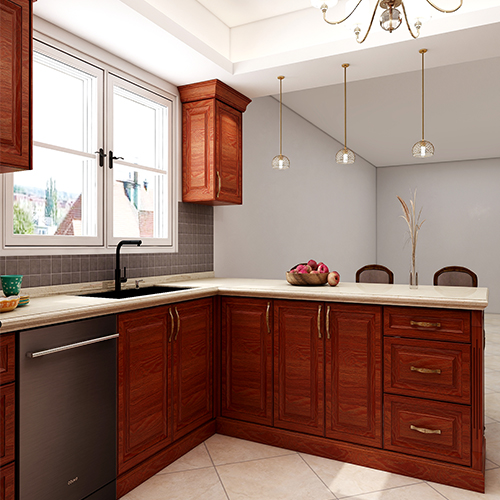
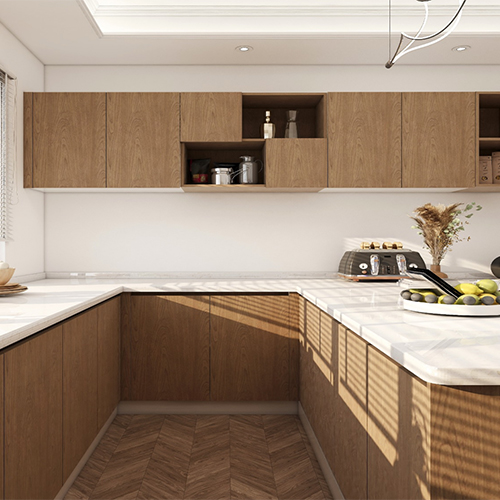
Quik look about solid wood kitchen cabinet:
| Pros of melamine kitchen cabinet | Cons of melamine kitchen cabinet |
|---|---|
| Timeless Aesthetics | Cost |
| Durability and Strength | Vulnerability to Moisture and Temperature Changes |
| Repairability and Refinishability | Maintenance Requirements |
| Environmental Sustainability | Weight and Installation Challenges |
Solid wood kitchen cabinet pros:
Timeless Aesthetics:
①Solid wood captivates with its innate natural beauty and the distinctive grain patterns unique to each species. Ranging from the straight, refined grains of maple to the bold, swirling patterns of oak, these variations lend character and visual interest to kitchen cabinetry. No two pieces are identical, imbuing every installation with a sense of exclusivity and connection to nature, transforming kitchens into warm and inviting spaces rich in organic texture and charm.
②Solid wood's inherent versatility makes it a harmonious element in diverse kitchen styles. Its organic warmth complements traditional and rustic designs, while sleek finishes suit modern and minimalist interiors. With a broad range of wood species, stains, and finishes available, solid wood cabinets can be tailored to match any aesthetic, from classic cherry in a rich stain for a colonial feel, to pale ash in a matte finish for a contemporary look, seamlessly integrating into any kitchen design vision.
③One of solid wood's greatest appeals lies in its vast potential for customization and finishing. From staining to enhance natural grains, to painting for a pop of color, the options are endless. Custom sizing, unique door profiles, and intricate carvings can all be achieved, reflecting personal taste and architectural details. Furthermore, as wood ages, it develops a patina, adding depth and character that synthetic materials can't replicate, ensuring a one-of-a-kind kitchen space.
Durability and Strength:
①Solid wood's resilience against wear and tear stems from its dense, robust nature. Its hardness can withstand daily use, resisting dents and scratches better than many synthetic materials. Natural imperfections acquired over time can often be seen as character enhancements, and with proper maintenance, such as occasional oiling or refinishing, solid wood cabinets can retain their beauty and functionality for decades, making them a durable and cherished investment.
②Solid wood cabinetry is renowned for its longevity, with the potential to become cherished heirloom pieces passed down generations. Its inherent strength allows for repairs and refinishing rather than replacement, ensuring a lifetime of service and beauty. As years go by, the wood develops a deeper patina, enriching its aesthetic appeal and embedding stories of family gatherings and daily rituals into the very fabric of the kitchen, symbolizing tradition and permanence.
③Solid wood cabinets exhibit remarkable resistance to everyday wear, including scratches, dents, and heat. Their dense composition absorbs impacts without cracking easily, and minor blemishes can often be sanded out, restoring the surface to its original elegance. While care should be taken around excessive heat sources, wood's natural thermal insulation properties protect it from quick temperature changes, preserving its structural integrity and aesthetic appeal over time.
Repairability and Refinishability:
①One of solid wood's unmatched advantages is its capacity to be sanded and refinished, rejuvenating its appearance. Over time, if the surface becomes worn or stained, skilled refinishing can erase signs of age, restoring the wood's luster and eradicating damage. This unique characteristic ensures that solid wood cabinets maintain their beauty indefinitely, adapting to changing decor trends or simply refreshing their look, a testament to the material's enduring appeal and value.
②The versatility of solid wood allows for easy transformation through staining or repainting, offering the freedom to refresh kitchen aesthetics as styles evolve. Whether opting for a new stain to enhance the wood's natural grain or applying a coat of paint for a completely different look, solid wood cabinets can adapt, providing a cost-effective route to redesign without replacing quality cabinetry. This adaptability ensures your kitchen remains stylish and personalized for years to come.
③Solid wood's reparability is a hallmark of its superiority. Unlike synthetic materials, damaged areas can be expertly repaired by skilled craftsmen, often seamlessly integrating the fix into the existing structure. Whether addressing scratches, dents, or more severe damages, the ability to restore without compromising the cabinet's overall integrity ensures a long-lasting solution that upholds both functionality and aesthetic appeal, further enhancing wood's reputation for endurance and value.
Environmental Sustainability:
①When sourced responsibly, solid wood is a renewable resource that supports sustainable forestry practices. Certified woods like FSC (Forest Stewardship Council) ensure trees are harvested ethically, with new growth planted to replace what is used. Choosing solid wood cabinets not only adds beauty and durability to your kitchen but also contributes to environmental conservation efforts, making it a responsible and eco-conscious decision for discerning homeowners.
②Solid wood cabinets are a biodegradable and non-toxic choice for eco-conscious consumers. At the end of their long lifespan, wood cabinets can naturally decompose, reducing environmental impact compared to synthetic materials. Moreover, they emit no harmful chemicals, promoting indoor air quality and a healthier living environment. Embracing solid wood cabinetry aligns with sustainability goals, offering a natural and safe option for families and the planet.
③At the conclusion of their functional life, solid wood cabinets hold immense potential for recycling or upcycling, furthering their sustainability credentials. Wood components can be repurposed into furniture, flooring, or decorative items, giving the material new life and reducing waste. This inherent recyclability extends the product lifecycle, conserves resources, and supports circular economy principles, making solid wood a wise and environmentally responsible investment for generations to come.
Solid wood kitchen cabinet cons:
1. Cost:
①While acknowledging that solid wood cabinets often command a higher initial investment compared to alternatives like MDF or particleboard, this upfront cost is offset by their exceptional longevity, durability, and potential for restoration. Considering the reduced need for replacements, enhanced aesthetic value, and positive environmental footprint, solid wood proves to be a cost-effective choice in the long haul, offering a blend of luxury and practicality to discerning homeowners.
②While solid wood cabinets may require higher maintenance and occasional refinishing costs, these expenses contribute to their lasting value. Regular care, such as oiling or refinishing, preserves the beauty and longevity of the wood and avoids premature replacement. Compared to the decades of service that solid wood provides, these investments protect the initial outlay, ensuring that the kitchen matures gracefully and retains its charm and practicality for generations.
2. Vulnerability to Moisture and Temperature:
①Wood's natural tendency to expand and contract with changes in humidity can lead to warping or cracking in solid wood cabinets. Maintaining consistent indoor humidity, sealing wood surfaces, and allowing for adequate air circulation help mitigate these effects, preserving the integrity and beauty of the cabinets over time. Regular inspections and prompt attention to any signs of moisture imbalance are crucial.
②Improper sealing or lack of maintenance in solid wood cabinets leaves them vulnerable to water damage, which can result in swelling, warping, or rot. Regular checks for leaks, sealing all surfaces with a high-quality finish, and swift action to address spills or moisture exposure are essential to prevent irreversible damage and prolong the cabinets' lifespan.
3. Maintenance Requirements:
①To prevent solid wood cabinets from absorbing moisture, it is vital to seal or oil them regularly. This protective measure can enhance the wood's natural barrier to moisture, reducing the risk of swelling, warping and rotting. Applying a new coat of wood sealer or oil, especially in high humidity areas, ensures that the integrity and appearance of the cabinets are protected long-term.
②Solid wood cabinets, if not cleaned promptly after spills, are susceptible to stains that can penetrate the wood grain, marring their appearance. Immediate attention with a damp cloth followed by drying can prevent absorption. Regular use of coasters, trays, and wiping up spills quickly are simple yet effective ways to avoid unsightly stains and preserve the wood's natural beauty.
③Over time, even with proper care, solid wood cabinets may require periodic refinishing to rejuvenate their appearance. Exposure to sunlight, daily wear, and the natural aging process can dull the finish and reveal scratches. Refinishing involves stripping the old finish, sanding, and reapplying stains or varnish, restoring the cabinets' luster and protecting the wood for continued use and enjoyment.
4. Weight and Installation Challenges:
①Solid wood cabinets, known for their substantial weight, necessitate robust wall supports to ensure safety and stability. Installing into studs or using heavy-duty brackets is imperative, as inadequate support can lead to cabinet detachment or wall damage over time. Proper installation techniques address this inherent heaviness, guaranteeing a strong and enduring fixture in your living space.
②The installation of solid wood cabinets can be complex, often requiring specialized skills and tools. Given their weight, need for precise leveling, and the importance of secure anchorage, hiring professional installers is advisable. Experts ensure correct installation, preventing damage to cabinets or property and achieving the desired aesthetic and functionality.
③Solid wood's weight and structural considerations sometimes impose limitations on upper cabinet sizes and configurations. Very large cabinets may require additional reinforcement or may not be feasible due to load-bearing concerns. Custom designs can accommodate aesthetic preferences while adhering to structural safety standards, which might involve creative layouts or strategic use of supports.
In conclusion, solid wood kitchen cabinet has a lot of advantages, including timeless aesthetics, durability and strength, repairability and refinishability and environmental sustainability. However, it also has some drawbacks, such as cost, vulnerability to moisture, maintenance requirements and temperature and weight and installation challenges. Ultimately, the decision to choose solid wood cabinet will depend on individual homeowners' preferences and priorities. It is important to weigh the pros and cons carefully before making a decision.
Hanse hot sale kitchen cabinets:
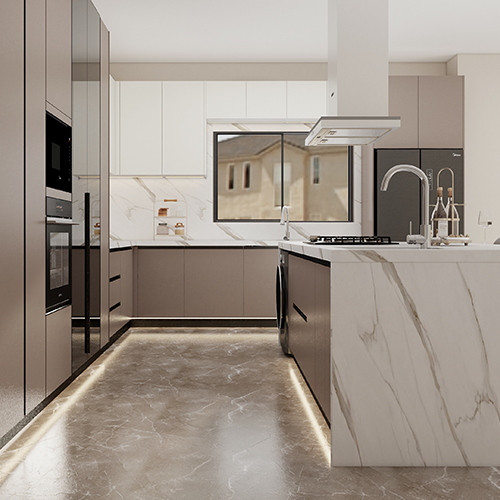
Acrylic Kitchen Cabinet
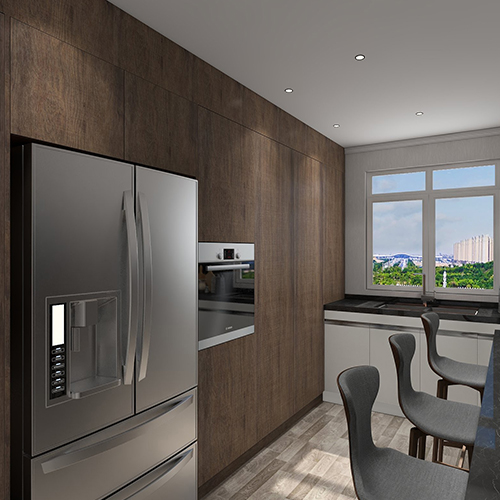
Glass Kitchen Cabinet
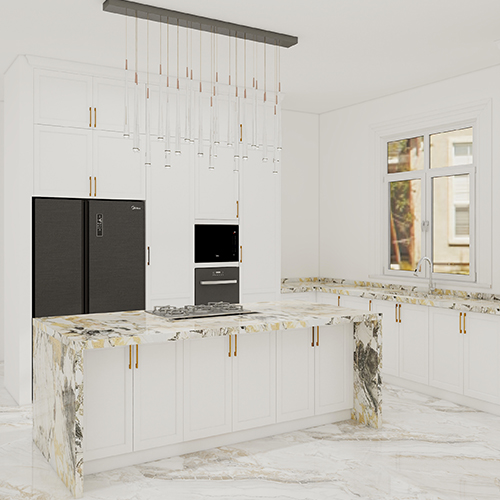
Lacquer Kitchen Cabinet
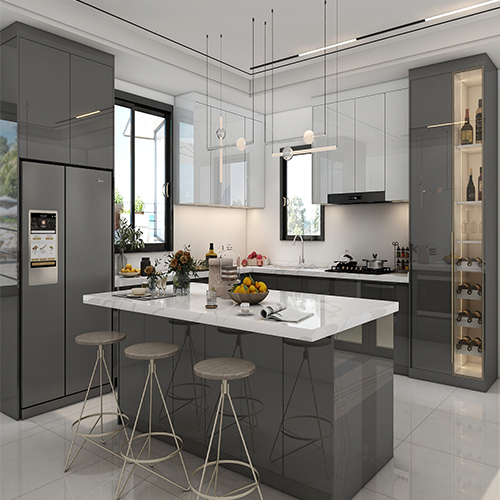
Melamine Kitchen Cabinet
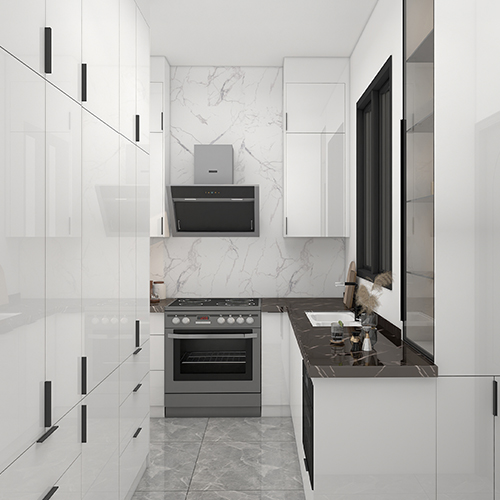
PVC Kitchen Cabinet
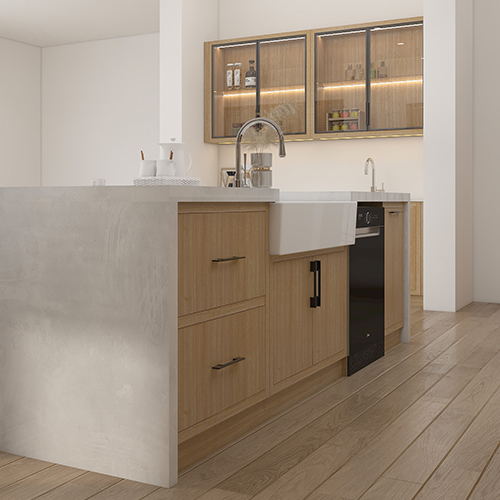
Shaker Kitchen Cabinet
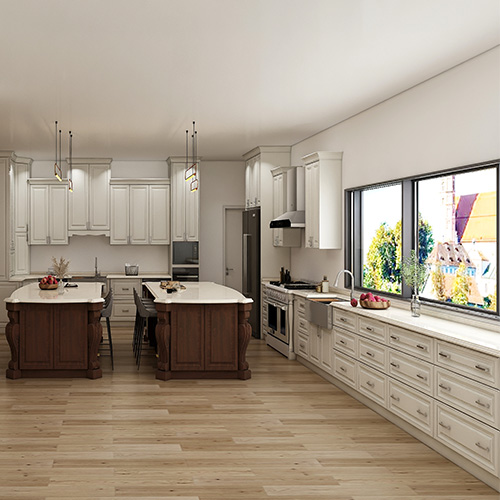
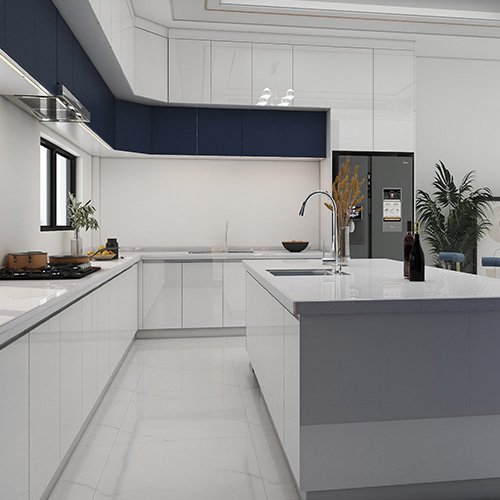
UV Kitchen Cabinet
Frequently Asked Questions:
1. How can I fix common problems like scratches or watermarks?
For minor scratches on the surface, you can try to wipe it gently with a soft cloth dipped in a small amount of olive oil or special wood furniture care oil, which will help fill the scratches and restore the gloss.
Deeper scratches may require a more detailed repair. Start by lightly sanding the scratched area with fine sandpaper, working in the direction of the wood grain until the surface is even. Afterwards, you can fill the scratch with a wood crayon or repair paste, and try to match the color of the furniture. After filling, lightly sand again and wipe clean, and finally apply a thin layer of wood wax for protection.
To prevent these problems, avoid placing hot items directly on the wooden surface, use coasters and tablecloths, and regularly use special cleaners and wood wax for cleaning and maintenance to maintain the protective layer on the wood surface.
2. What are some seasonal maintenance tips to prevent damage?
Maintaining solid wood cabinets throughout the year can significantly extend their lifespan and preserve their beauty.
As the weather warms up, give your cabinets a thorough cleaning to remove any accumulated grime or grease from winter cooking. Use a mild soap solution and a soft cloth, avoiding excess water which can cause swelling.
Spring often brings humidity. Check for any signs of moisture damage or warping. If found, address the source of moisture immediately and consider using a dehumidifier.
Direct sunlight can fade or discolor wood over time. Install blinds or curtains to shield your cabinets from intense sunlight during peak hours.
Summer humidity can also affect wood. Maintain a consistent indoor humidity level between 40% and 60% to prevent swelling or shrinking.
Before the cold sets in, inspect cabinets for any small nicks or scratches. Repair them now to prevent moisture from seeping in during winter months.
Winter's dry air can cause wood to dry out and crack. Use a humidifier to maintain humidity levels and prevent excessive dryness.
Related articles
PVC Kitchen Cabinets: Advantages and Disadvantages
Advantages and disadvantages of UV kitchen cabinets
Stainless Steel Kitchen Cabinet: Pros and Cons

